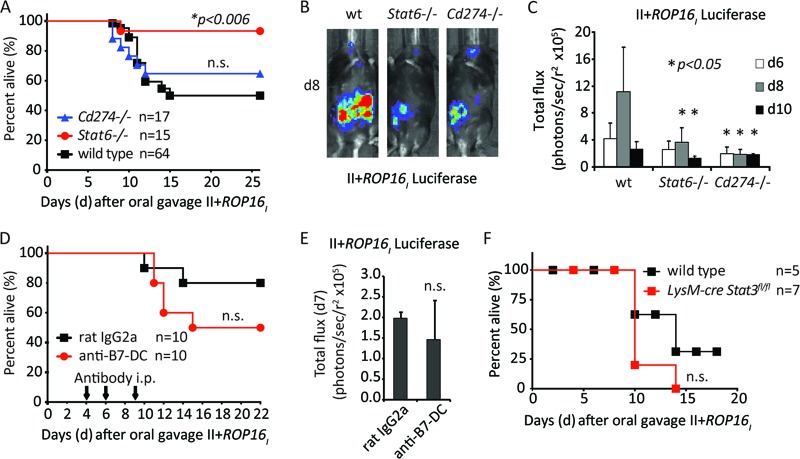Fig 2.
Host resistance to the II+ROP16I strain occurs in the absence of B7-H1 and STAT6. (A) Cumulative survival data for Cd274−/−, Stat6−/−, or wild-type C57BL/6 mice orally challenged with the II+ROP16I strain. The total number (n) of mice orally challenged is listed. The Mantel-Cox test was used to address significant differences (P < 0.05) in survival between knockout and wild-type mice (n.s., not significant). (B) Representative whole-body bioluminescence images of individual knockout or wild-type (wt) mice on day 8 following oral infection with strain II+ROP16I. (C) Average bioluminescence (number of photons/s/r2) detected by whole-body imaging of wild-type and knockout mice on various days following oral infection with strain II+ROP16I. Bars depict the mean bioluminescence of the cohort + SD (n = 5 per group). Asterisks indicate statistically significant differences (two-tailed Student t test, P < 0.05) in luminescence between knockout and wild-type mice on that particular day. (D) C57BL/6 mice were injected i.p. with a neutralizing antibody against B7-DC or with isotype control antibody on days 4, 6, and 9 following oral challenge with the II+ROP16I strain. The cumulative results from two experiments are plotted; the number of mice for each treatment is indicated (Mantel-Cox, P = 0.2; n.s., not significant). (E) As in panel D, but the average bioluminescence obtained from whole-body imaging on day 7 following oral challenge with the II+ROP16I strain is plotted (Student t test, P = 0.3). (F) Survival curves of Stat3fl/fl (wild type) or Stat3fl/fl LysM-cre mice following oral infection with the II+ROP16I strain. The combined results of two individual experiments are plotted, and the number of mice challenged is indicated (Mantel-Cox test, P = 0.3).

